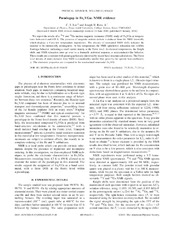| dc.creator | Lue, C. S. | |
| dc.creator | Ross, Joseph H. Jr. | |
| dc.date.accessioned | 2016-01-15T06:32:05Z | |
| dc.date.available | 2016-01-15T06:32:05Z | |
| dc.date.issued | 2001 | |
| dc.identifier.citation | Phys. Rev. B 63, 054420 (2001) | en |
| dc.identifier.uri | https://hdl.handle.net/1969.1/156035 | |
| dc.description.abstract | We report the results of a 51V and 69Ga nuclear magnetic resonance (NMR) study of Fe2VGa at temperatures between 4 and 450 K. The presence of magnetic antisite defects is deduced from the NMR linewidth, which displays a Curie-law temperature dependence. The absence of associated NMR shifts indicates the material to be intrinsically nonmagnetic. At low temperatures the NMR spin-lattice relaxation rate exhibits Korringa behavior, indicating a small carrier density at the Fermi level. At elevated temperatures, the Knight shifts and NMR relaxation rates go over to a thermally activated response, a semiconductor-like behavior. These results are consistent with pseudogap features identified by recent band structure calculations. The Fermi level density of states deduced from NMR is considerably smaller than given by the specific heat coefficient, γ. The electronic properties are compared to the isostructural semimetal Fe2VAl. | en |
| dc.language.iso | en_US | |
| dc.publisher | American Physical Society | |
| dc.title | Pseudogap in Fe2VGa: NMR evidence | en |
| dc.type | Article | en |
| local.department | Physics and Astronomy | en |
| dc.identifier.doi | 10.1103/PhysRevB.63.054420 | |


